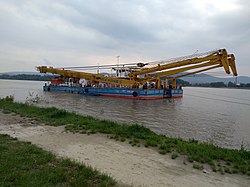|
Clark Ádám (crane vessel)
Clark Ádám is a crane vessel, specifically a floating sheerleg, built in 1980 in Budapest, Hungary, by the Hungarian Shipyards and Crane Factory (Hungarian: Magyar Hajó- és Darugyár; MHD) Angyalföld Division. It originally had a lifting capacity of 120 metric tons, gradually raised to 200 tons by 2006,[3] making it one of the largest in lifting capacity on Central European rivers.[4][5] It is mainly used for building bridges, but is also commissioned to assist salvage operations, as well as to launch hydrofoils. It has rescued several ships; in 2019 it raised the sunken Hableány from the Danube at Budapest. The vessel is named after Scottish engineer Adam Clark (1811–1866).[2] CharacteristicsThe floating crane is powered by two Scania DS 14 diesel engines, each of 520 hp (390 kW).[4] Its fuel tank has a capacity of 60,000 litres (13,000 imp gal; 16,000 US gal), which allows for 200 hours of operation. The two engines are mounted on rubber stands to minimize vibration and noise. They each have their own helms, but the second helm is only used to stop the vessel, or when the vessel gets caught on a shoal. Its maximum speed is around 16–17 kilometres per hour (9.9–10.6 mph). Every ten years the vessel undergoes maintenance and repair in a dry dock in Austria.[2][4] HistoryThe vessel was commissioned by the Capital City Council (Fővárosi Tanács) of Budapest to assist the expansion of Árpád Bridge, as the two other floating cranes available at the time (named after Attila József and Endre Ady) were deemed unsuitable. The cost was covered by the council and the vessel was donated to Bridge-building Company (Hídépítő Vállalat, later becoming Hídépítő Speciál), as the company itself did not have sufficient funding. The final cost of Clark Ádám was 100 million Hungarian forints.[6] It was launched on October 21, 1980.[7] It was also used to build other bridges, like the Pentele Bridge,[8] or the Megyeri Bridge. It is also commissioned to launch hydrofoils.[4] Clark Ádám is actually the second vessel intended for the Árpád Bridge construction. The first one (TOEC, yard number 2370) was only partially built when it was sold to a Syrian company in February 1980.[4][2][9] The floating crane was originally designed with two lifting capacity of 100 (boom with 20 m lifting platform) and 120 ton metric (boom with 10 m lifting platform) in 1980.[10] In 1997, Ganz Danubius Vitla improved it to a 150-ton capacity with a new propulsion and later, in 2006, to a 200-ton capacity.[3] Notable involvements 
References
External linksWikimedia Commons has media related to Clark Ádám (ship, 1980). |
||||||||||||||||||||||||||||||||||||||||||||||||||||
